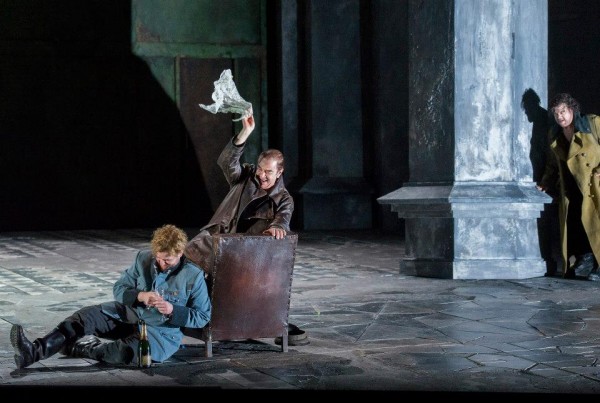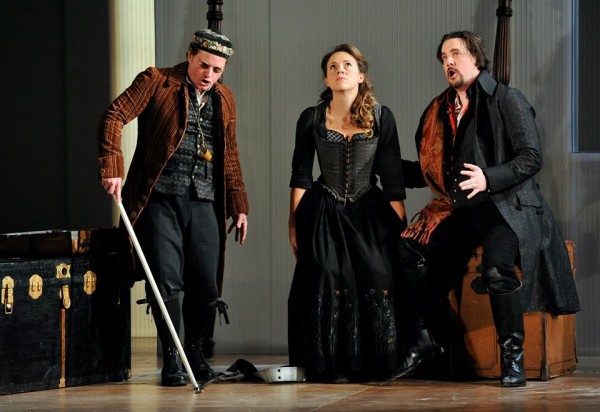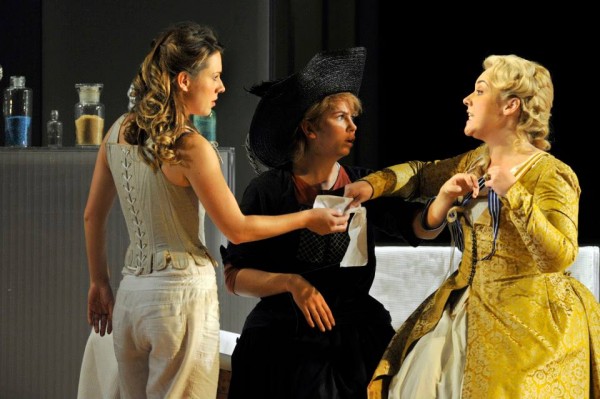Music
Tragedy and Comedy, Passion and Joy at the ENO
As I illustrated in my previous article, opera can sweep you from each extreme of the emotional spectrum to the other, one work exposing the rawest nerves of passion, another joyously tickling your funny bone, both delighting in equal measure. So it has been with my recent trips to one of the UK’s greatest operatic institutions, the English National Opera.
Founded in 1889, the ENO has resided at the Coliseum in St. Martin’s Lane in London’s bustling Covent Garden since 1968, nestled amongst the pubs, bars, restaurants and venues, only a short walk away from Leicester Square tube station. Unlike that other great London opera destination, The Royal Opera House, the ENO performs all of its works in English and has a particular emphasis on the dramatic elements of its productions, as opposed to the puristic musicality of its more elite counterpart. It’s altogether a more accessible and engaging establishment, fitting in nicely with the musicals and plays of the West End that surround it. It also has surtitles (so called because they are placed above the stage, as opposed to the subtitles one finds in foreign language films) that handily translate the action as it’s happening (even when sung in English, opera is rather difficult to follow).
It was in this marvelous space that I got to experience their rendition of two very different works representing the typical Romantic and Classical styles. First up was Otello by Giuseppe Verdi, his Italian take on Shakespeare’s tragic tale of jealously and deceit. Completed in 1886, only three years before the ENO itself was established, it is the penultimate of Verdi’s operas and he is, along with Giacomo Puccini, the standard-bearer of the Romantic, post-Wagnerian operatic style.
It opens in a storm, the full chorus on stage blasting from the first note, foregoing an overture and getting right to the action. The set design (Jon Morrell) was a minimal, stark, yet evocative depiction of a late-19th Century mediterranean garrison town. Opera offers a rare opportunity for directors (in this case David Alden, hot off of a recent critically-acclaimed production of Benjamin Britten’s Peter Grimes) and producers to let their hair down and play with expectations, but nothing over the top was attempted here, the simple stone walls economically but effectively setting the scene as the drama played out.
Opera can often reduce its characters to broad-stroke caricatures, but Verdi goes further in fleshing out the lead roles here, in particular those of Otello (a commanding Stuart Skelton) and Iago (Jonathan Summers providing a suitably sinister presence). The whole work is sung straight through, with little to distinguish the transition from aria to aria and the cast performed beautifully, bringing the heartfelt passion of the style to the fore with aplomb. With Opera, you’re often left crying or laughing depending on the material and with a Shakespearean tragedy as the source, you can imagine where this performance leaves you. A rich and rewarding evening of culture.
The other performance I had the pleasure of attending was from the opposite side of the operatic coin: Mozart’s Classical comedic masterpiece, The Marriage of Figaro, which has just started its run. When it comes to opera, I always say you can’t really go wrong with the Mozart offerings, especially if you’re new to the genre. The plots are invariably silly, convoluted, light-hearted affairs, involving cross-gender misunderstandings, marital indiscretions, wry class observations and simple jokes and fun, all of which are, naturally, woven through with sublime music.
Unlike the unbroken, ernest lyricism of Verdi’s Romantic style, there are clear song sections (arias) and the connecting half-spoken/half-sung exposition sections (recitatives), which keep the action moving along. Most people attending will recognise at least a third of these arias, saturated as they are with tunes that have trickled through to modern popular culture (anyone who’s seen the Shawshank Redemption will immediately know one of the songs for instance). Familiarity with a tune actually goes a long way to help someone new to opera enjoy their first outings, which is one of the reasons I recommend the Mozarts to anyone starting out.
So bearing in mind that any bog-standard performance of this most famous of works by probably the most famous classical composer known to anyone will be at least enjoyable, it’s even more fantastic when executed with such style, wit and innovation as the current run at the ENO. From the very first moment, when the orchestra begins the famous overture to the sounds of a buzzing bee trapped inside a pianoforte by Figaro, I knew we were in for an rare treat.
As the opening instrumental frolics continued, instead of a plain curtain to peruse as normal, we got to witness the revolving set – a series of plain white rectangular walls arranged to represent the rooms, halls and boudoirs of an aristocratic mansion – spin as the cast and chorus ran around and about the construction acting out little dramas and stories of their own before the play began, giving us a real, immediate sense of the scene and setting of the action to come. It was a particularly dynamic and refreshing way to begin the opera and one that set the tone of the impending hi-jinks. Director Fiona Shaw (the actress that once starred in the Harry Potter films) really brings something new and vibrant to this much beloved classic and the production fizzes along from beginning to end.
The cast are uniformly excellent and have a real chemistry with each other, clearly enjoying the cross-dressing, bed-hopping machinations of the plot and the many crowd-pleasing asides and japes. Stand-out performances amongst a strong ensemble include David Stout as the titular hero (who plays wonderfully off of Benedict Nelson as the Count) and in particular Samantha Price as the amorously-insatiable page-boy Cherubino (a “breeches role”, where a woman plays the part of a man, sometimes even, as here, dressing up as a woman), who had the audience in stitches with her charming, fumbling foibles. The standout was perhaps the dulcet tones and arresting stage presence of Mary Bevan as Figaro’s exasperated fiancé Susanna, who was presented with the Critics Circle Award for Exceptional Young Talent at the curtain call, much to the approval of those attending.
Honestly, this is one genuinely funny opera and you can’t say that about many of them. You’ll be laughing all night, leaving with a huge smile on your face and great tunes on your lips. If you’ve never been to the opera before you couldn’t ask for a better work, production or venue to start out than this gem. It’s on now at the Coliseum until 23rd November. Go on, treat yourself.
Find tickets to The Marriage of Figaro, here and Otello, here.









